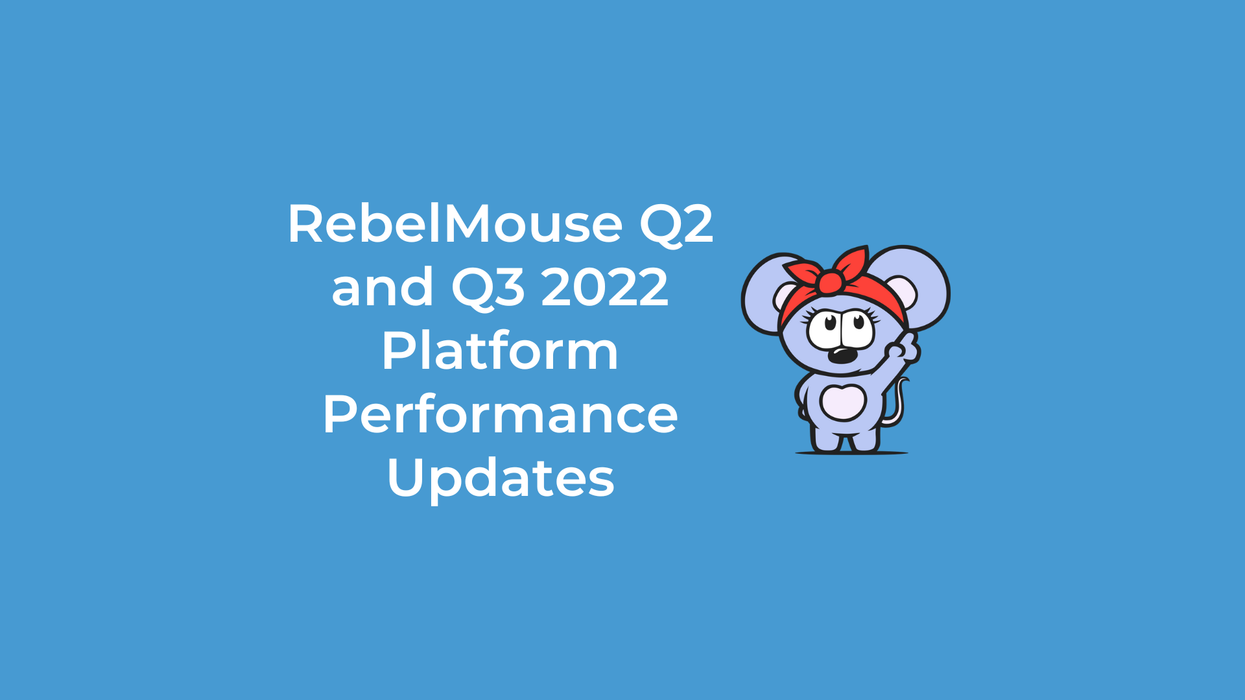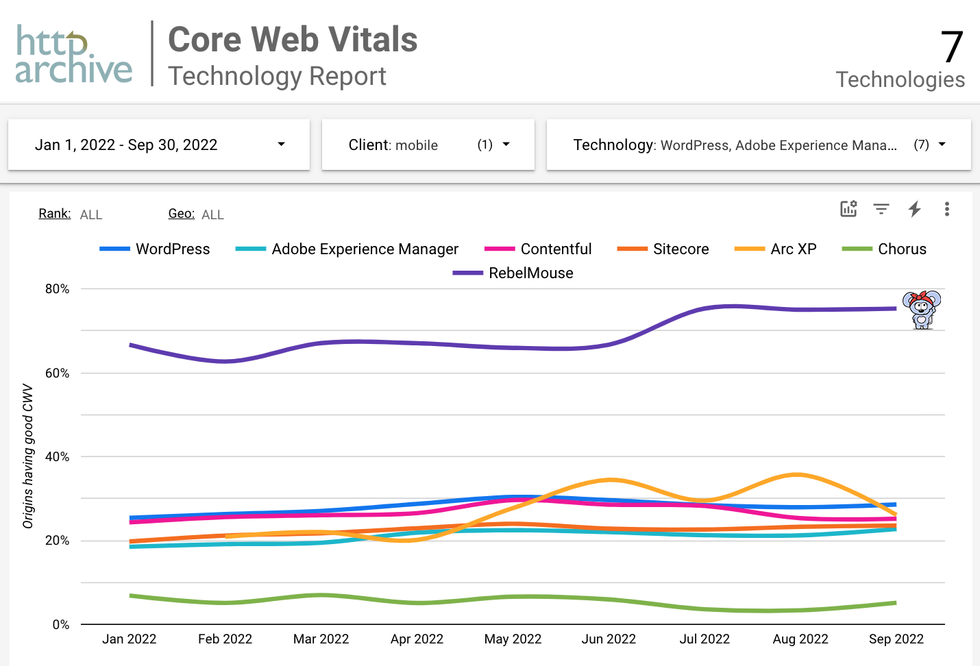Click here to read our Q1 2022 platform performance updates.
Click here to read our Q4 2021 platform performance updates.
Click here to read our Q3 2021 platform performance updates.
Click here to read our Q2 2021 platform performance updates.
Click here to read our Q1 2021 platform performance updates.
It has been a busy 2022 for RebelMouse, which is why we’ve combined our Q2 and Q3 platform performance updates into one post. But this doesn’t mean that we haven’t been working at our consistent, high level as usual to ensure that our platform is the highest performing on the web.
HTTP Archive, a resource that crawls the web to identify trends and record historical patterns, tracks how well top content management systems (CMS) perform against Google’s most critical metrics in its Core Web Vitals Technology Report. According to data from January 2022 to September 2022, RebelMouse continues to rise above the competition:
In addition to making sure that we power the fastest sites on the web, we’ve invested 3,668 hours into our platform in Q2 2022 and Q3 2022 alone. All of the sites on our platform benefited from the work in various ways. Here are the key areas that we focused on:
- 1,540 hours spent on performance updates
- 830 hours spent on delivering new features
- 548 hours spent on improving existing features
- 750 hours spent on infrastructure updates
Platform Updates and Improvements
Sticky B-Tests
Multivariate testing tools are almost entirely built in JavaScript to make them easy to deploy. Unfortunately, all those tools share a huge technical issue. In order to run a test, you need the initial page to load and rewrite the page. Otherwise, you need the dependent JavaScript, which is a load-blocking resource and causes performance issues.
That’s why we invested time to build native testing tools that allow you to run tests that are rendered server side and at super high performance. This is the cleanest way to get great data. Recently, we upgraded these tools so that you can set tests to be “sticky,” which means that whatever multivariate test a user received on the first page load will stick with them as they navigate. This is an awesome tool to use to test the launch of a site redesign. Click here to read more about our multivariate testing tools.
Dynamic Insertion of Ads Into a Post Body
For media companies, displaying ads every certain amount of characters or paragraphs is a huge revenue source. We’ve supported this for years, but we recently upgraded the feature to give developers on our platform the ability to set rules so that some types of posts can avoid the ads in the article body, while others run them fully. This new level of control can be very valuable, particularly for sponsored content that shouldn’t have ads inserted, as well as other special editorial conditions.
New Custom Dashboard Creations
Our Layout & Design Tool has always had the ability to completely customize any page on your website. Our Entry Editor is completely customizable as well. We recently upgraded Layout & Design Tool so that you can also now create custom dashboard pages for your editorial and operation teams. These can be tremendously useful for custom solutions for your enterprise to build key reports and interactions. Additionally, this opens up a whole new field of customizations of RebelMouse by any developer using our platform.
QuoteMedia Integration
We’ve added an integration with QuoteMedia to interact with Entry Editor so that media companies that are covering public companies can easily look up stock symbols and company names. We've also automated the process of gathering all the key structured data for each company, as well as their logo, name, and links to social media channels. This is a huge opportunity for those covering the finance sector to boost SEO traffic while also making editorial teams more efficient.
Sweetwater Affiliate Program API Integration
Sweetwater is an online retailer and affiliate marketing company that focuses on the entertainment and music industry. It is now integrated seamlessly into RebelMouse so that media companies can build affiliate revenue off of musical product recommendations. Click here to read more about affiliate marketing on RebelMouse.
Next-Generation Redirects Dashboard
Our redirects dashboard has always made it simple to manage redirecting one URL to another, particularly for posts. We’ve recently upgraded this to a new dashboard that allows you to control redirects for any author, section, and/or tag. The dashboard also controls the type of redirects you can configure, so you can add 301s and 302s in place without the need for developer support.
Distribution Errors Dashboard
We recently built some key upgrades to manage when social publishing fails for technical reasons. This allows you to gather the full details and monitor if the source of the problem is from the social media channel or somewhere else.
Jira Integration With Layout & Design Tool
We’ve upgraded Layout & Design Tool so that you can now easily associate a new B-test with a Jira ticket. This is tremendously useful because you can now group a bunch of tests together in one ticket and test them all together as a batch. This has made developers on our platform that are working on complex projects more efficient and organized.
Breadcrumb Support for Primary Sections
We’ve supported many ways to enable breadcrumbs for users and in structured data, but recently added a more efficient way to manage the Primary Section as part of the breadcrumb.
Updated Stripe Integration
Stripe made some key upgrades to their platform which required all developers using their technology to make similar upgrades to remain compliant. We’ve completed that integration work so that all Stripe integrations are modern and set for the future.
Documents API
We’ve recently added support in our API to manage documents. This allows you to use our API to manage, insert, edit, and/or update documents like PDFs and associate them with posts.
AMP Support for Float Images
AMP has its own language, and we’ve recently upgraded our AMP integration so that you can choose to have images float to the left or right elegantly, which allows for more design flexibility. It’s worth noting that Google is moving away from AMP in the not-so-distant future, but it continues to be an important part of the traffic picture for many of our clients.
Upgraded Error Handling for Facebook Instant Articles and Apple News
We’ve significantly upgraded how we handle moments when Facebook’s API is down for Instant Articles, including similar issues for Apple News. Our code now retries, catches errors, and reports them back. We are also handling massive GIF images through next-generation image approaches.
Improved Test Coverage
We are constantly adding new regression testing and automated-release software so that we can catch more possible scenarios on our release clusters. We added hundreds of new tests in Q2 2022 alone.
Performance and Infrastructure Updates
Talaria: Smart Cache Updates
We’ve made significant progress on what we used to call Smart Cache, which is now named Talaria after the winged sandals that make you fly. We are now outperforming every other CMS on the market on server response time when there is a CDN miss. This is fantastic for long-tail SEO and how Google crawls your site.
We’ve also introduced a “pre-warm” concept so that sites that launch on RebelMouse can have every new page perform at incredible levels immediately. We cover the super-long-tail SEO where CDNs are always missing because so few people visit a page, but collectively there are so many low-traffic pages. This has given us a significant performance boost.
Pharos: Real-Time Core Web Vitals
Google’s PageSpeed Insights gives you a very nice snapshot into your site’s performance, but it’s designed to show a 28-day average of your performance. This means that whenever you make a big performance update to your site, it’s going to be nearly a month until you know if your update helped or hurt your site.
At RebelMouse, we believe that you shouldn’t have to wait to know what’s happening to your site. That’s why we created the Core Web Vitals dashboard. With this dashboard, you can see your Core Web Vitals performance in real time, and measure your performance against your traffic. Click here to learn more.
Python Upgrade
Upgrading versions of Python can be a painful process, but part of staying modern is making sure that we aren’t running on outdated core technologies. We’ve completed the latest Python upgrade and will continue to keep it modern.
Assets Optimizer
Assets optimizer is enabled by the RebelMouse team as a back-end option that does the following:
- Collects all of the style blocks on a page
- Parses the style blocks and goes through each of the selectors to make sure they’re used on the page by checking to see if each style selector exists on the page
- In cases where they’re not used, the style is put into a separate stylesheet and removed from the page
- In cases where they are used, the style is left on the page
Improvements: Lightweight Exporter for NGINX Logs
We are constantly improving how quickly we can release new code in a very stable way through our continuous deployment process. This upgrade significantly speeds that process up.
Improvements: New AMI for WFEs
AWS is constantly releasing new AMIs that developers can take advantage of, but they are time consuming to set up and configure. We have now taken advantage of that for all of our front-end servers.
Improvements: Sped up Node.js Apps by Preventing CPU Throttling
We added both stability and performance by preventing CPU throttling on our Node.js apps.
EKS 1.21 Integration
Kubernetes is a very powerful technology we use to help us manage server clusters. We recently upgraded to their 1.21 version. Release notes with details can be found here.
Crons in Kubernetes
Kubernetes has become the best place to set up cron jobs, and we are now integrated so that we can fully support them.
Click here to read our Q1 2022 platform performance updates.
Click here to read our Q4 2021 platform performance updates.
Click here to read our Q3 2021 platform performance updates.
Click here to read our Q2 2021 platform performance updates.
Click here to read our Q1 2021 platform performance updates.


